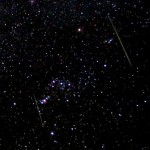The meteor wildcard of 2014 is something new. Several meteor experts are predicting a possible shower from comet 209P/LINEAR. The Earth will pass close to the debris stream from this comet in late May this year, possibly creating a decent meteor shower, or even a meteor storm.

Of greatest potential significance this quarter, indeed this year, is an encounter between the Earth and a number of dust trails left by Comet 209P/LINEAR at its perihelion returns within twenty years to either side of 1900 AD. Several predictions have already been issued for what may occur, and further updates are likely nearer the event. Based on the most recent independent calculations by Esko Lyytinen, Mikhail Maslov and J´er´emie Vaubaillon, the strongest activity from this source should happen on May 24, most likely between about 07h to 08h UT from a radiant near the borders of Lynx, Ursa Major and Camelopardalis, quite close to o UMa. The predicted radiant locations fall within a few degrees of α = 124° , δ = +79° . Timings in UT for the centre of the strongest activity overall are around 07h 03m (Lyytinen), 07h 21m (Maslov) and 07h 40m (Vaubaillon) respectively.
However, much is unknown about this comet, including its dust productivity and even its precise orbit. Consequently, while tentative proposals have been made that ZHRs at best could reach 100+, perhaps up to storm proportions, based purely on the relative approach distances between the Earth and the computed dust trails, these are far from certain. The strongest activity could be short lived too, lasting perhaps between a few minutes to a fraction of an hour only. In addition, the number of dust trails involved means there may be more than one peak, and that others could happen outside the “key hour” period, so observers at suitable locations are urged to be vigilant for as long as possible to either side of the predicted event to record whatever takes place.
Remember, there are no guarantees in meteor astronomy! Lunar observing circumstances are very positive, with May’s new Moon on the 28th. The north-circumpolar radiant area for many sites means the three main geographic zones where most radio observers are located – Europe, North America and Japan – should be able to follow all that occurs, interference permitting. The time of year means the northern nights are close to their shortest for visual and imaging work, but the predicted strongest activity timings fall perfectly for night-time coverage all across North America and the nearby oceans to its east and west.
–IMO Website 2014 Calendar
The takeaway from what we know… This shower is highly uncertain, we could get anything from nothing to meteor storm. The peak will be short and sharp, lasting only a few hours. With a peak near 07:00-08:00hUT on May 24th, observers in the Pacific should be alert from 21:00 to 22:00HST on the evening of the 23rd. New Moon occurs on the 28th, indicating there should be no moonlight to contend with.

